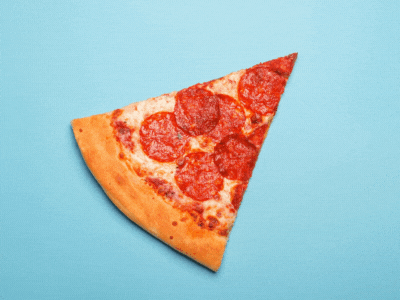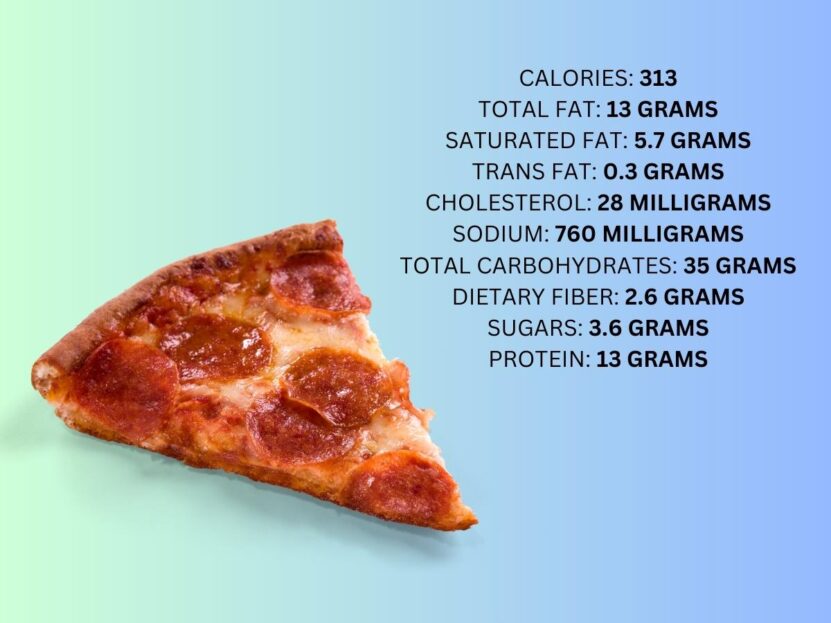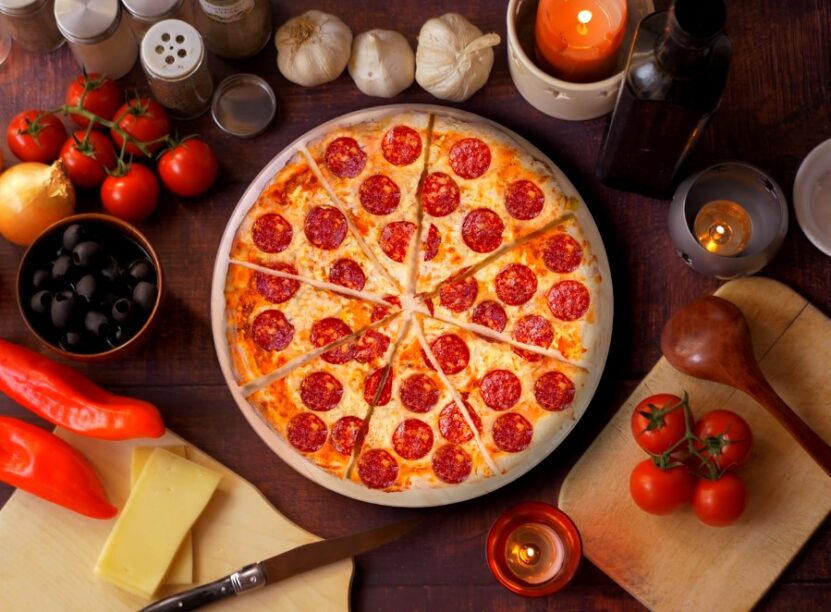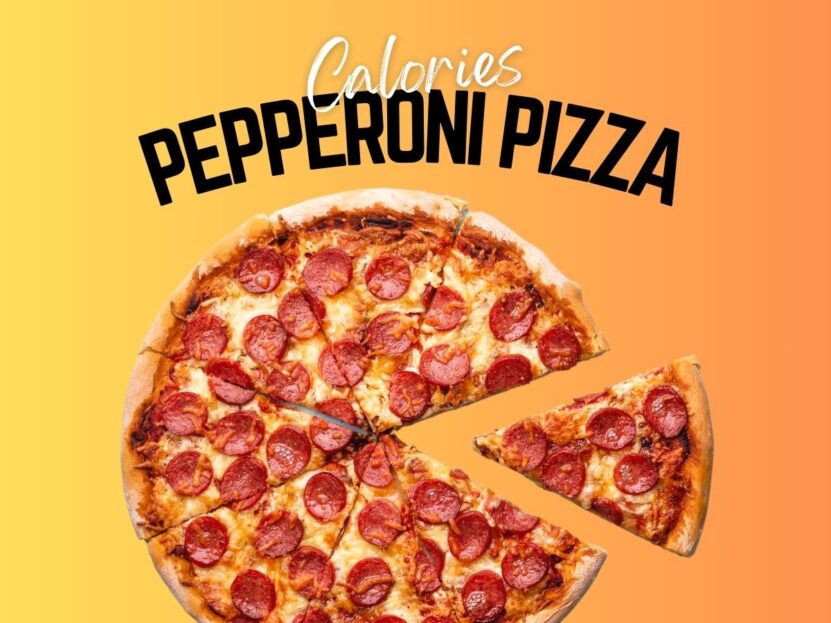Pizza, especially the pepperoni variant, is a beloved dish worldwide. Its savory taste, combined with the crispy crust and melted cheese, makes it a favorite for many.
But have you ever paused to think about the nutritional value of that delicious slice? Let’s dive deep into the world of pepperoni pizza and demystify the calorie count.

The Basic Numbers
According to the Nutritionix Database, a typical slice of pepperoni pizza (weighing around 111 grams) contains:
- Calories: 313
- Total Fat: 13 grams
- Saturated Fat: 5.7 grams
- Trans Fat: 0.3 grams
- Cholesterol: 28 milligrams
- Sodium: 760 milligrams
- Total Carbohydrates: 35 grams
- Dietary Fiber: 2.6 grams
- Sugars: 3.6 grams
- Protein: 13 grams
These values are based on a daily diet of 2000 calories, which is the general nutrition advice for adults.

Calories in Pepperoni Pizza: A Deeper Dive
The number of calories in a slice can vary depending on a number of factors, including the size of the slice, the thickness of the crust, the amount of cheese and pepperoni used, and the brand of the dish.
However, in general, a slice of pepperoni pizza typically contains between 250 and 450 calories.
Main Factors
- Size of the slice: The larger the slice, the more calories it will contain. A standard slice is typically about 1/8 of the whole pizza, but some pizzerias offer larger slices. A large slice can contain up to 450 calories.
- Thickness of the crust: A thicker crust will have more calories than a thinner crust. A thin-crusted slice typically contains around 250 calories, while a hand-tossed or pan-style slice can contain up to 350 calories.
- Amount of cheese and pepperoni: The more cheese and pepperoni used, the more calories the slice will contain. A slice of pepperoni pizza with a generous amount of cheese and pepperoni can contain up to 500 calories.
- Brand of pizza: Different brands of pizza can have different calorie counts. For example, a slice from Domino’s Pizza typically contains 280 calories, while a slice of pepperoni pizza from Pizza Hut typically contains 300 calories.
Type

The type of pizza also plays a role in its calorie content. For instance:
- Deep Dish: A slice of deep-dish pepperoni pizza that is 14 inches in diameter can contain around 400-500 calories or more, depending on the thickness of the crust and the amount of cheese and toppings.
- Frozen: A frozen pepperoni pizza slice can contain around 250-300 calories, depending on the brand and size.
- Gluten-Free: A slice of gluten-free pepperoni pizza can contain around 200-250 calories. However, gluten-free options may not necessarily be healthier or lower in calories than their traditional counterparts.
- Vegetarian: Depending on the size and thickness of the crust, and the quantity of cheese and toppings, a slice of vegetarian pepperoni pizza may have 200–300 calories.
- Organic: Organic pizzas, which use ingredients that are free from synthetic additives, might have a slightly different calorie count due to the natural ingredients used. However, the calorie difference might not be significant.
- Gourmet: Gourmet pizzas often come with a variety of toppings and unique ingredients, which can affect the calorie count. Ingredients like truffle oil, gourmet cheeses, or specialty meats can add to the calorie content.
Additional Considerations
- Sauces and Drizzles: Some pizzas come with additional sauces or drizzles, like garlic butter, ranch, or barbecue sauce. These can add extra calories to your slice.
- Dough Ingredients: The type of flour used, the presence of sugar or oil in the dough, and other ingredients can also influence the calorie content.
- Cheese Types: Not all cheeses have the same calorie count. Mozzarella, which is commonly used on pizzas, has a different calorie count than cheddar or feta.
Remember, while counting calories is essential for those watching their weight or trying to maintain a healthy lifestyle, it’s also crucial to consider the nutritional value of the food. A slice with fresh vegetables and lean protein might have more calories than a plain cheese slice but can be more nutritious.
Burning Off Those Calories

Ever wondered how much exercise you’d need to burn off the calories from that slice? Here’s a quick breakdown:
- Walking (3mph): Approximately 84 minutes
- Running (6mph): Around 30 minutes
- Bicycling (10mph): Roughly 43 minutes
These estimates are based on a person weighing 140 lbs. Remember, the exact time can vary based on your weight, metabolism, and intensity of the exercise.
Tips for Reducing Calorie Content
- Order a smaller slice: This can significantly reduce the calorie intake. Opting for a personal-sized pizza or a smaller diameter can help control portion sizes.
- Choose a thin-crust pizza: As mentioned, thin crusts generally have fewer calories. Additionally, opting for crusts made with whole wheat or alternative grains can offer added nutritional benefits.
- Ask for less cheese and pepperoni: This can help in reducing the fat and calorie content. Consider asking for half the usual amount of cheese or opting for lighter cheese options like feta or goat cheese.
- Share a pizza with a friend: This can help in portion control. Splitting a pizza ensures you don’t overeat and can also make the dining experience more enjoyable.
- Top your pizza with vegetables instead of meat: Vegetables generally have fewer calories and can add nutritional value. Options like bell peppers, onions, mushrooms, spinach, and tomatoes can enhance flavor without adding many calories.
- Make your own pizza at home with healthier ingredients: This gives you control over the ingredients and their quantities. Using whole grain crust, homemade tomato sauce without added sugars, and fresh toppings can make your pizza healthier.
- Opt for leaner meats: If you’re a meat lover, consider toppings like grilled chicken or turkey instead of higher-fat options like sausage or bacon.
- Be mindful of sauces: Some pizzas come drizzled with extra sauces like garlic butter, ranch, or barbecue. Asking for these on the side or skipping them altogether can save on calories.
- Choose a salad on the side: Instead of ordering extra slices or side dishes like garlic bread, opt for a fresh salad. This can help fill you up with fewer calories and add beneficial nutrients to your meal.
- Limit or avoid stuffed crusts: Stuffed crusts, especially those filled with cheese or meats, can significantly increase the calorie content of your pizza.
- Stay hydrated: Drinking water before and during your meal can help you feel full faster, reducing the number of slices you might consume.
- Be cautious with all-you-can-eat deals: While they might seem like a good value, they can encourage overeating. Stick to a set number of slices and listen to your body’s hunger cues.
Remember, the key is moderation. Enjoying a slice now and then won’t derail your health or fitness goals, especially if you’re mindful of the choices you make and balance it out with physical activity.
FAQ
What is the difference in calories between a slice of pepperoni pizza and a slice of cheese pizza?
A slice of pepperoni pizza typically contains about 25-50 more calories than a slice topped with cheese. This is because pepperoni is a high-fat food, and the extra cheese used to top the slice also adds calories.
How many calories are in a slice of pizza from different restaurants?
The calorie content of a slice of pizza from different restaurants can vary significantly. For example, a slice of pepperoni pizza from Domino’s Pizza typically contains 280 calories, while a slice of pepperoni pizza from Pizza Hut typically contains 300 calories.
It is important to check the nutrition information on the pizza label or website before you order to find out the exact calorie content.
Is it okay to eat pizza if I’m trying to lose weight?
Pizza can be part of a healthy diet, but it is important to eat it in moderation. If you are trying to lose weight, it is best to limit yourself to one slice per day and pair it with other healthy foods, such as vegetables and salad.
What are the healthiest toppings to choose for a pepperoni pizza?
Vegetables like bell peppers, mushrooms, onions, and spinach are healthier toppings as they add nutritional value without significantly increasing the calorie content.
How does frequent consumption of pepperoni pizza affect weight?
Regularly consuming high-calorie foods like pizza without balancing it with physical activity can lead to weight gain. It’s essential to enjoy such foods in moderation.
Last Words
While it’s essential to be aware of the calories you consume, it’s equally important to enjoy your food. Pepperoni pizza, when consumed in moderation and as part of a balanced diet, can be a delightful treat. So, the next time you grab a slice, savor it, enjoy every bite, and maybe take a brisk walk afterward!
